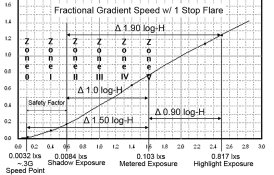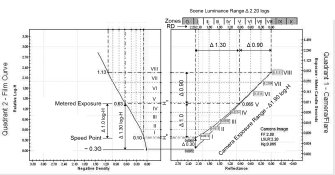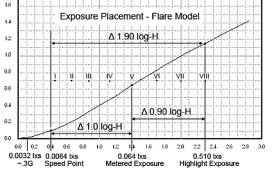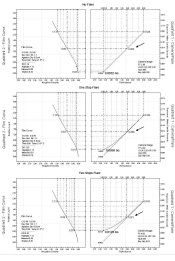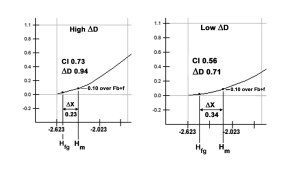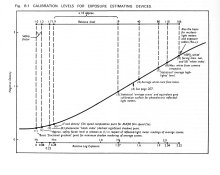So, how do we know the speed point metered exposure ratio is 1.20 log-H or 16x (15.8) for Zone System testing? Its right there in the Zone System testing instructions. Meter a card and stop down four stops. Zone I is the speed point and it is at 0.10 over Fb+f. Four stops of exposure is 1.20 log-H.
It should be obvious at this point that for a 125 speed film where the speed point has an exposure value of 0.0064 for Hm has to have an EI lower than 125 for the 1.20 log-H range to fit between the metered exposure and the speed point. What would that EI need to be?
Exposure constant / (Hm * ratio) = EI
or
8 / (0.0064 * 15.8) = 79.2
or
EI 80
A film with an ISO of 125 and a speed point metered exposure ratio of 16 (1.20 log-H) will have an EI of 80. Of course, Zone System testing gets to this same conclusion differently.
Traditional Zone System testing is done in camera which means people are far more limited in the exposure information available to them than if they used a sensitometric approach. A card is metered and the camera is stopped down four stops. (While the Zone System test uses only a single tone, the graphs illustrate how the the full exposure range would fall.) Below is an example of how the exposure will fall with a 125 speed film metered using an EI of 125.
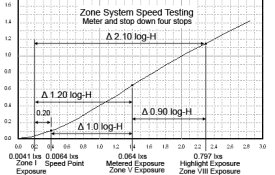
Zone I exposure will fall 0.20 log-H units below the 0.10 speed point. Exposure needs to be increased by 0.20 log-H in order to bring the Zone I exposure up from 0.0041 lxs to 0.0064 lxs. While the film speed remains at 125, the meters EI is now at 80. This is what creates the change from the speed point - metered exposure ratio of 10x (1.0 log-H) to 16X (1.20 log-H).
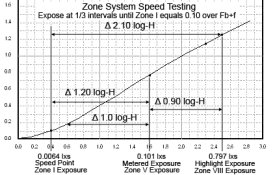
Doesnt the first Zone System testing example look a lot like the sensitometric exposure example? The only difference is the choice of scene luminance ranges. The Zone System uses 2.10 and tone reproduction uses 2.20. So the only difference between the two is the sensitometric example has the shadow fall 1/3 stop further down on the curve.
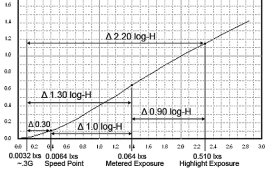
The final step is where a lot of people get tripped up. Theres a difference between the scenes luminance range and the cameras exposure range. While the original scene might have a luminance range of 2.20, by the time it gets to the film plane, the exposure range averages at least a stop smaller: 1.90. Sensitometric testing is done in non-flare conditions, so the interpretation of the sensitometric results has to incorporate flare. While the difference between the metered exposure point of the subject and the shadow has a difference of 4 1/3 stops, on the film plane it is only 3 1/3 stops. It's not a coincidence that the ISO standard has a speed point - metered exposure ratio of 1.0 (3 1/3 stops) and not 1.30 (4 1/3 stops).
While the Zone System testing utilizes a camera, the flare is practically non-existent by the way the test is conducted, so it too can be considered non-flare testing conditions. So, just like what was done with the earlier sensitometric example, the exposure range needs to be adjusted to account for flare. To simplify thing, Ive reduced the exposure range to 1.90 log-H.
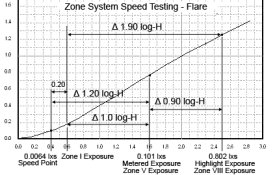
Its interesting how similar this example is to the fractional gradient example, but it shouldnt surprising. Both the Zone System and 0.3G were developed in the early 1940s. At that time they had a good correlation between the two results. Take a look at their speed point metered exposure ratios. While at first the fractional gradients 1.50 might not seem to match the Zone Systems 1.20, if you adjust for the 0.3G having a speed point approximately one stop (0.30 log-H) units to the left of the Zone Systems speed point, they are the same.

It wasnt until the 1960 standard reduced the safety factor and changed the speed point metered exposure ratio which then caused the resulting speeds from the Zone System and the ANSI/ISO method to diverge.















